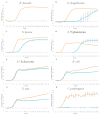Antimicrobial Activity of Peptides Produced by Lactococcus lactis subsp. lactis on Swine Pathogens
- PMID: 37570251
- PMCID: PMC10416947
- DOI: 10.3390/ani13152442
Antimicrobial Activity of Peptides Produced by Lactococcus lactis subsp. lactis on Swine Pathogens
Abstract
Swine production is of great importance worldwide and has huge economic and commercial impact. Due to problems with bacterial infection, the use of antimicrobials has increased in the last decades, particularly in Latin America and Asia. This has led to concerns about antimicrobial resistance, which poses risks to human health and the environment. The use of probiotic organisms has been proposed as an alternative to this use, as these beneficial bacteria can produce antimicrobial peptides, such as bacteriocins, which allow the induction of inhibitory effects against pathogenic microorganisms. Among probiotics, some bacteria stand out with the inhibition of animal pathogens. The bacteriocin-like inhibitory substances (BLISs) of Lactococcus lactis subsp. lactis strain L2, present in its cell-free supernatant, were tested against pathogenic strains isolated from pig samples, such as Escherichia coli, Salmonella enterica, Streptococcus suis, Streptococcus dysgalactiae, Staphylococcus hyicus, and Enterococcus faecalis. Compounds secreted by L. lactis L2 have been shown to inhibit the growth of some pathogenic species, particularly Gram-positive bacteria, with S. suis being the most prominent. Antimicrobial peptides with a molecular size of 500-1160 Daltons were isolated from BLISs. The results highlight the potential of L. lactis BLISs and its peptides as natural antimicrobials for use in the food industry and to reduce the use of growth promoters in animal production.
Keywords: Lactococcus lactis; bacteriocin; lactic acid bacteria; peptides; pig.
Conflict of interest statement
The authors declare no conflict of interest.
Figures




References
-
- Calderón Díaz J.A., Fitzgerald R.M., Shalloo L., Rodrigues da Costa M., Niemi J., Leonard F.C., Kyriazakis I., García Manzanilla E. Financial Analysis of Herd Status and Vaccination Practices for Porcine Reproductive and Respiratory Syndrome Virus, Swine Influenza Virus, and Mycoplasma hyopneumoniae in Farrow-to-Finish Pig Farms Using a Bio-Economic Simulation Model. Front. Vet. Sci. 2020;7:556674. doi: 10.3389/fvets.2020.556674. - DOI - PMC - PubMed
-
- Pietrosemoli S., Tang C. Animal Welfare and Production Challenges Associated with Pasture Pig Systems: A Review. Agriculture. 2020;10:223. doi: 10.3390/agriculture10060223. - DOI
-
- Álvarez-Pérez S., Blanco J.L., Astorga R.J., Gómez-Laguna J., Barrero-Domínguez B., Galán-Relaño A., Harmanus C., Kuijper E., García M.E. Distribution and tracking of Clostridium difficile and Clostridium perfringens in a free-range pig abattoir and processing plant. Food Res. Int. 2018;113:456–464. doi: 10.1016/j.foodres.2018.07.040. - DOI - PubMed
Grants and funding
LinkOut - more resources
Full Text Sources

